
In the prefecture-level city of Taizhou in Jiangsu province, power worker Dai Yongdong is jubilant about the rapid advancements in technology that have ushered in a variety of possibilities for his work: ensuring electricity safety and power grid stability in the region.
As director of the smart operation and maintenance center under State Grid Taizhou Power Supply Co, he has witnessed the installation of 207 next-generation DJI fixed-wing drone airports across its service territory.
The installation, completed at the end of March, marked the official launch of Jiangsu's first low-altitude smart inspection network. Covering transmission, substation, and distribution facilities of all voltage levels, the network is a milestone as it is China's first prefecture-level drone operating center under the State Grid system.
"We intend to establish a leading standardized low-altitude smart service platform in the country," Dai said.
This year's Government Work Report, delivered during the annual two sessions in Beijing, has called for the development of new-generation intelligent terminals and smart manufacturing equipment.
Yang Yi, Dai's colleague, said embodying State Grid's digital transformation strategy, the automated drone inspection ecosystem can cover the entire 5,700-square-kilometer jurisdiction in Taizhou, which administers three county-level cities and three districts.
Yang said they have integrated into their fleet drones with advanced technologies, such as high-definition video transmission, infrared thermography, and laser scanning systems.
In a demonstration flight on April 14, the No 001 drone departed from Mazhou Island in the county-level city of Jingjiang and returned safely, beaming the inspection data back to the terminal within five minutes.
"This system fundamentally redefined the grid inspection workflows," said Dai, claiming that drones can autonomously complete takeoff, mission execution, return, recharging and data transmission.
Meanwhile, integrated AI diagnostics also enable real-time defect identification, reducing on-site manpower by 85 percent, he said.
Currently, the network can oversee 6,434 kilometers of electricity transmission lines, 19,037 km of distribution lines, and 181 substations.
"With the new facilities, we have increased our equipment inspections from once a quarter to four times each month, and raised the checking frequency on substations to once every three days, thus achieving round-the-clock multidimensional status monitoring," Dai stressed.
The State Grid Taizhou Power Supply Co began pioneering an "Aerial Digital Inspection System" in March 2023, breaking traditional inspection limitations, said Yang.
Following pilot trials of 21 drone bases in urban districts, the power company optimized its strategic placement and autonomous flight path planning under a coverage framework of 3 km in urban areas, 5 km in suburbs, and 7 km in rural zones, and the full-scale deployment started in October 2024.
These "aerial sentinels" conduct thorough inspections of power facilities, while AI image recognition enables real-time fault analysis and precise defect localization.
In addition, 3D models generated via laser scanning provide navigational precision for fault remediation, thus ushering in a new era of grid inspection efficiency, Yang added.
Qian Ping, Yang's colleague, claimed that the system has employed an innovative "Task Work Order + Autonomous Decision-Making" operational model.
With the 207 drone bases executing over 2,484 daily sorties, each unit can achieve 12-15 hours of effective operation — tripling the inspection efficiency compared to manual methods, she said.

